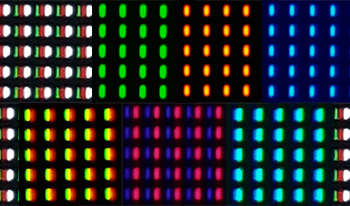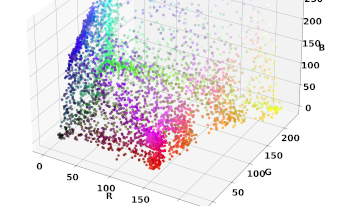
Accurate color reproduction on a display requires an inverse display model, mapping colorimetric values (e.g. CIE XYZ) into RGB values driving the display. To create such a model, we collected a large dataset of display color measurements for a high refresh-rate 4-primary OLED display. We demonstrated that, unlike traditional LCD displays, multi-primary OLED display color responses are non-additive and non-linear for some colors. We tested the performances of different regression methods: polynomial regression, look-up tables, multi-layer perceptrons, and others. The best-performing models were additionally validated on newly measured (unseen) test colors. We found that the performances of several variations of 4th-degree polynomial models were comparable to the look-up table and machine-learning-based models while being less resource-intensive.

The JAB Code, a 2D barcode standardized in ISO/IEC 23634:2022, offers improved reliability and data capacity over traditional barcodes, but its color recognition poses challenges. These issues stem from the suboptimal utilization of the RGB color space in printing and the non-bijective RGB-to-CMYK conversion, prompting the need to select colors that ensure distinct segregation in the transformed color space for enhanced detection robustness. We propose an approach for calibrating the colors of the JAB Code, involving the creation of a test pattern, quantization of the color space, and the calibration of colors using a calibration target. This method aims to ensure optimal color representation within the barcode and can be integrated into JAB Code generation tools or web apps, simplifying the process for users and ultimately improving color accuracy and fidelity within the barcode. We conduct an experiment with different printers, utilizing a smartphone for image capture. The evaluation includes printing JAB Code test patterns, creating and calibrating standard and calibrated JAB Codes, and capturing images under various lighting conditions. We use the JAB Code detection algorithm to analyze color distances in the RGB space, revealing improvements in color distribution and lower error rates with printer color calibration, which can lead to faster reading processes and smaller JAB Code sizes with reduced area requirements. This work offers important insights that should be considered during the next revision of the ISO standard.

Color targets come in different designs, sizes and surface finishes. A high quality color target such as the Next Generation Target (NGT)1, designed for the Library of Congress, has a glossy finish that makes it sensitive to the light-setup geometry. When the NGT color target is to be captured orthogonally, i.e. both the camera and the light share the same plane and lie on the normal of the target’s surface, even with cross-polarization in place it is not possible to completely eliminate the high reflections caused by the camera/light geometry – unlike for less glossy color targets such as the X-Rite SG CC- not even if the camera/light setup were to be tilted at different angles. We are demonstrating in this paper that it is possible, however, to deploy a mosaic approach to capture the NGT color target at a tilted angle, masking out the reflections, and composing a rectified mosaic image out of only the clear parts of the target. The resultant ICC color correction profile for the mosaic image is proved to be viable to put in use and it satisfies all the necessary metrics for ISO level ”A” when it comes to color calibration and color accuracy.